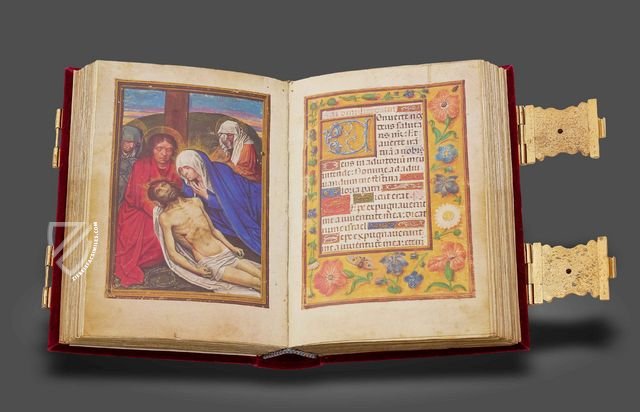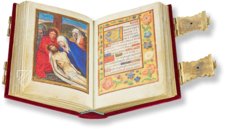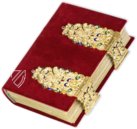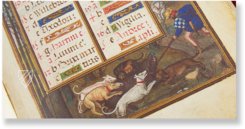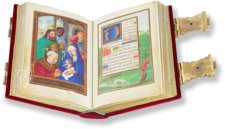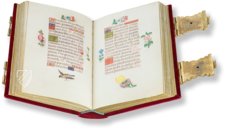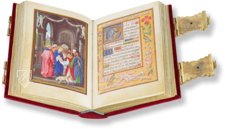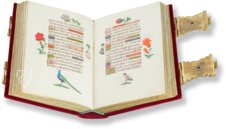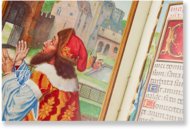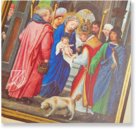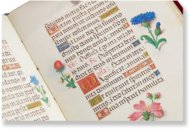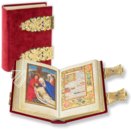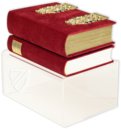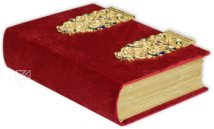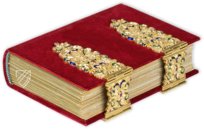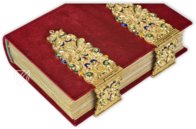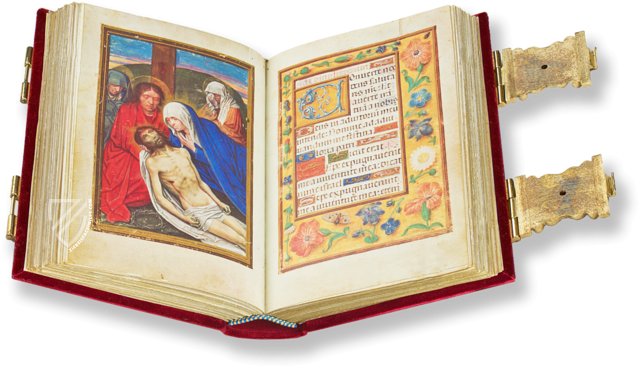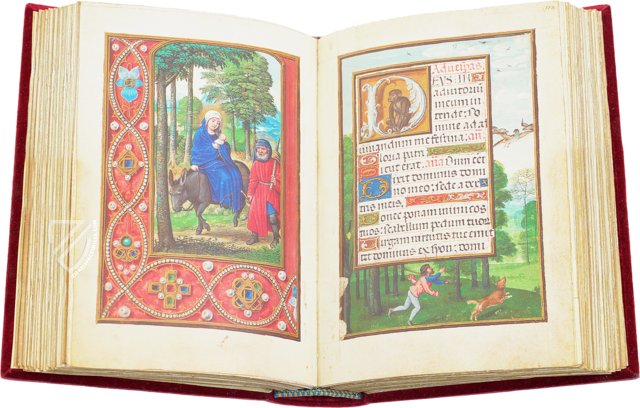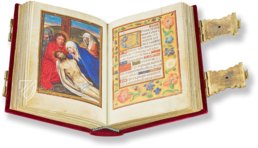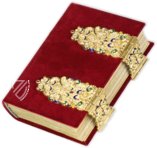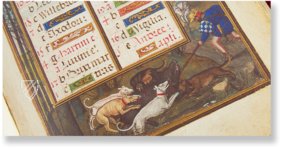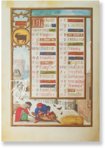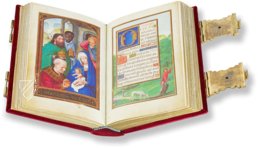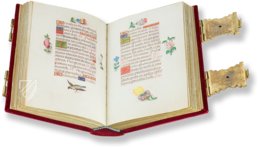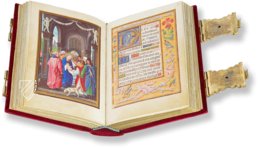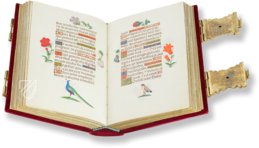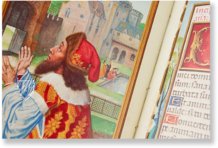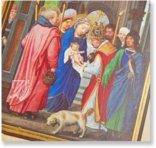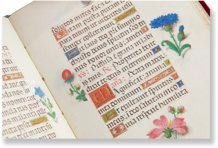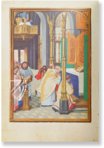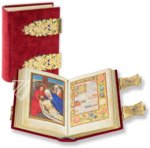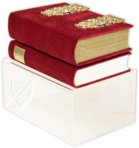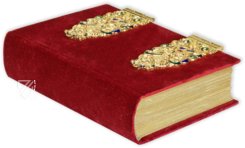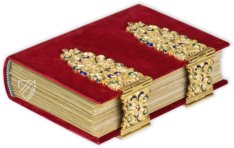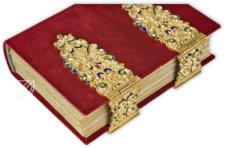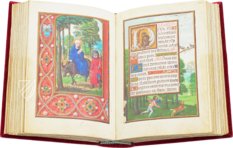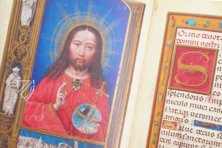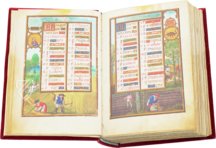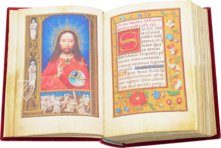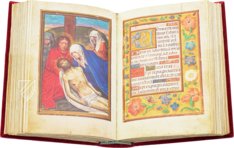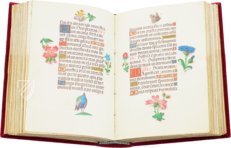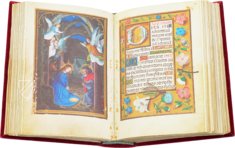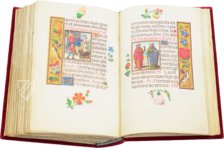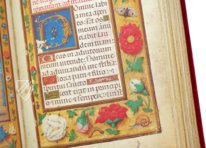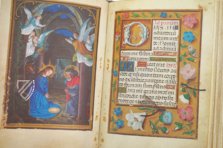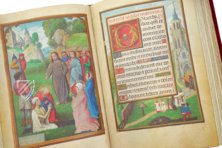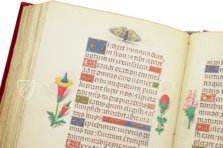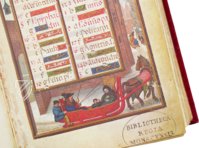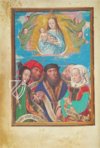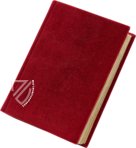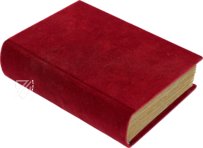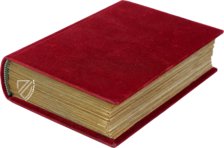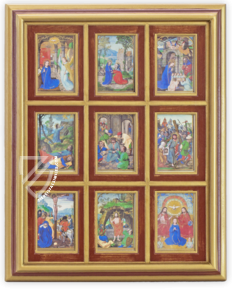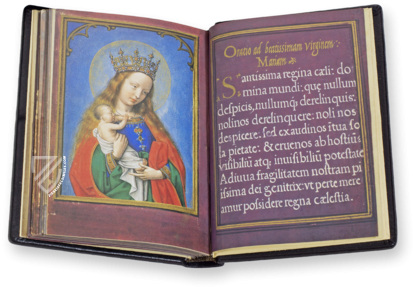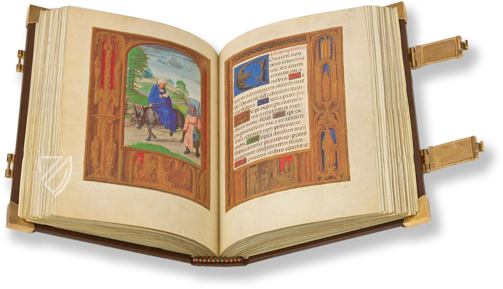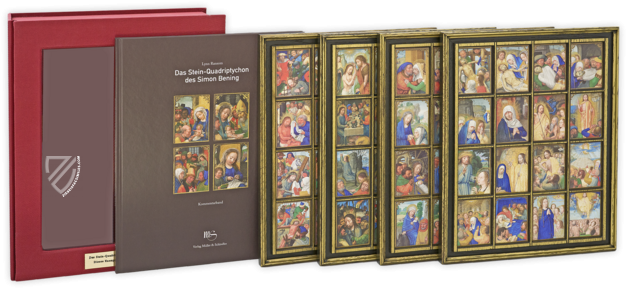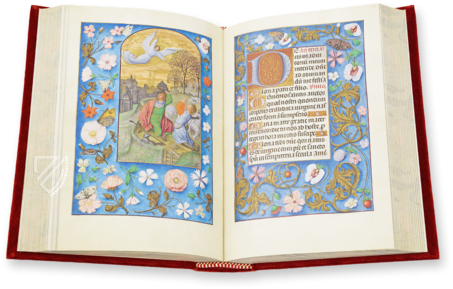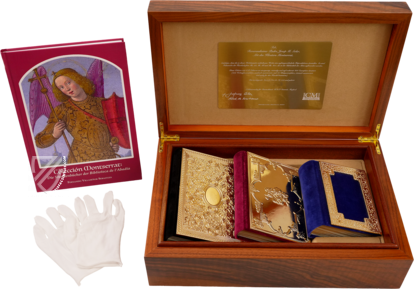Simon Bening's Flowers Book of Hours
(3,000€ - 7,000€)
Sometime in the time period from 1520 to 1525, the famous Flemish book artist, Simon Bening, created one of his greatest works, namely the so-called Flowers Book of Hours. He completed the illuminated manuscript in his workshops in Ghent and Bruges and furnished it with incomparable full-page miniatures and marginal decoration on each page of text. The variety of forms of design that Bening chose for the private prayer book is impressive and he modelled his miniatures on the work of Hugo van der Goes and Martin Schongauer. Aside from the 70 enchanting full-page miniatures, the manuscript contains over 300 pages showing a wealth of decorative motifs consisting of buds and flowers of every kind as well as small birds and insects, which appear incomparably plastic and realistic. 12 lovingly designed calendar pictures show everyday scenes from the life of the predominantly peasant population.
Simon Bening's Flowers Book of Hours
The so-called Flowers Book of Hours is not only one of the most beautiful and splendid masterpieces by the famous illuminator Simon Bening, it is simultaneously counted among the most valuable illuminated manuscripts that was ever made. The religious text of the work is designed according to the internationally available pattern of medieval books of hours. It begins with a calendar, followed by an introductory prayer and excerpts from the four Gospels. Further textual components are an Office of the Virgin, Office of the Dead, as well as penitential Psalms and prayers to high saints. The manuscript displays an incomparable variety of various design patterns. Nearly every page of the private devotional and prayer book is artistically illustrated. Alongside 70 enchanting full-page miniatures, the manuscript contains over 300 pages with uniquely plastic decorations from patterns of plants and animals.
The Flemish Master of Book Art
Simon Bening, son of the miniaturist Alexander Bening, was born in the Belgian city of Bruges ca. 1483. He learned the craft of illumination in the workshop of his father. During his education, he became familiar with the works of great book-artists like Gerard Horenbout, with whom he would produce the greatest illuminated manuscripts of the Netherlands a few years later. Bening began to work independently from 1500 on and in was accepted into the illuminators’ guild of Bruges in 1508. That was a privilege that was awarded to only the most gifted masters of the discipline. By 1525 at the latest, Simon Bening was the undisputed star of the illumination scene in the Late Middle Ages. The Portuguese diplomat and humanist Damião de Góis named him “the best master of book illustration in all of Europe”. His handmade, unique illuminated manuscripts are kept safe in the most-renowned museums worldwide.
Unmistakable Illumination
The Flowers Book of Hours has, for several reasons, a unique and unrivalled position in the history of medieval manuscripts. For a start, there is no other work of this kind that effectively contains decorations on every page of text. Colorful patterns in an unending variety of designs and lavish gold adornment beam across from the beholder on every page. Equally astounding is the manner in which Simon Bening interpreted his artistic examples in his painting. He experimented with the most varied models in his miniatures, from panel paintings from the Old Dutch painter Hugo van der Goes to the engravings of the of the copperplate engraver and painter Martin Schongauer. He modified these masterful examples unbelievably creatively in his own pictures, combining them with new artistic ideas and expanded them with unmistakable individual motifs.
The Charming and Creative Likenesses of the Work
The full-page miniatures of the Flowers Book of Hours reproduce an astonishingly broad spectrum of typical medieval activities and customs. 12 lovingly designed calendar pictures show everyday scenes from the life of the predominantly peasant population. One shows farmers, as they perform their work in the field through the course of the year. Likewise, the miniatures show typical leisure activities that one pursued as pastimes in the Middle Ages. Boat parties and sled-rides are among them, even a knight’s tournament is depicted. The fantastical pictures were accompanied by unbelievably imaginative and plastic-looking marginal decorations. Playful patterns of buds and flowers of every kind, of little birds and insects, were set in the bordures of the scenes. Bening was able to lend his fantastical depictions an incomparably plastic and real appearance through his shadowy outlines. Without a doubt, the Flowers Book of Hours is a unique masterpiece of medieval book art.
Codicology
- Alternative Titles
- Blumen-Stundenbuch von Simon Bening
Blumenstundenbuch von Simon Bening - Size / Format
- 438 pages / 16.5 × 11.2 cm
- Origin
- Belgium
- Date
- 1520–1525
- Epochs
- Style
- Genre
- Language
- Script
- Gothic Textura
- Illustrations
- Each single page illuminated: 70 miniature pages and more than 300 pages showing a wealth of decorative motifs, particularly flowers, birds and other animals
- Content
- Liturgy of the Hours
- Artist / School
- Simon Bening (1483–1561)
- Previous Owners
- Charles Theodore, Prince-Elector of the Palatinate and Bavaria (1724–1799)
Simon Bening's Flowers Book of Hours
Singing a Hymn
As three priests wearing splendid cloth of gold brocade vestments kneel and bow at the altar with a folding triptych, a choir of men and boys can be seen singing behind them. They are huddled around a lectern with a gradual, a medieval songbook whose notation was written large enough to be seen from a distance, as it is here. One man in light blue is looking out at the beholder with his mouth open in mid-song, almost as though we had just walked in and were about to interrupt the service.
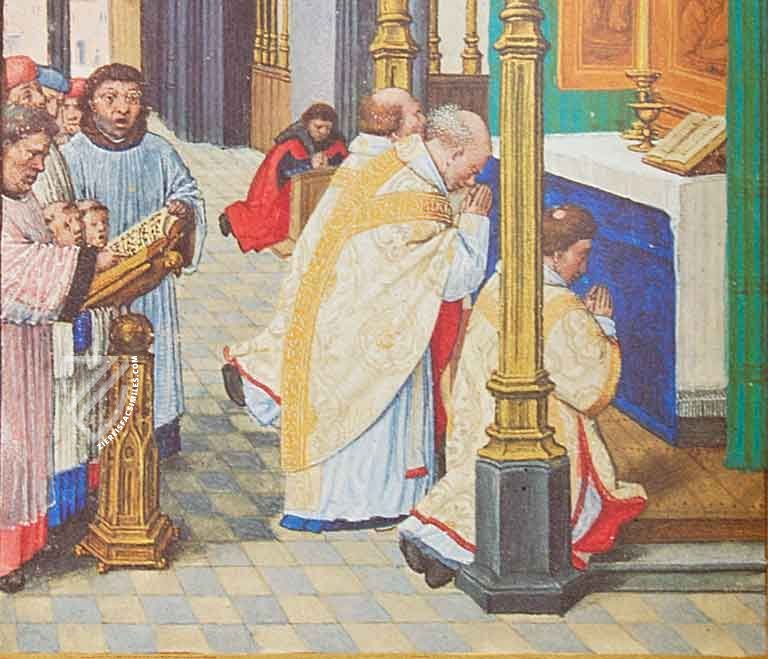
Simon Bening's Flowers Book of Hours
December: Slaughtering Swine
This intimate labor of the month is presented within a delicate frame, all rendered with the refinement one would expect of the great Simon Bening. The Capricorn zodiac symbol reinforces what month it is, indicated in the table at the top by the letters “Deceb”.
In the bas-de-page miniature beneath the calendar itself, we see a pig being slaughtered, a typical scene for the month when salted meat was usually being stockpiled for the winter. Its blood, a rich source of iron, is being carefully collected. Freshly fallen snow covers the landscape, including the gatehouse with drawbridge in the background, perhaps an entrance to a city or castle where the pig might be taken to market. Chickens and dogs wander aimlessly while a bonfire burns in the background.
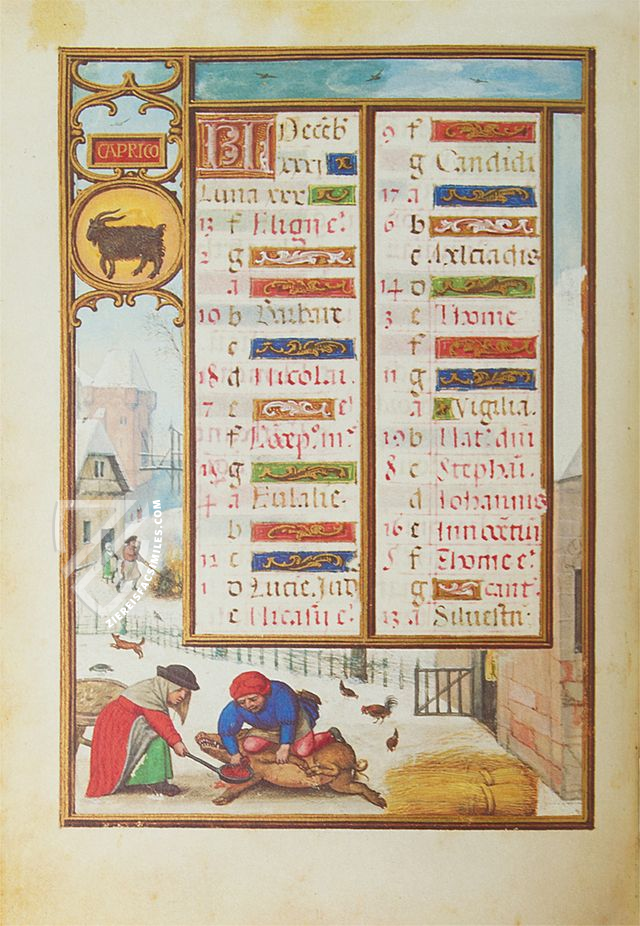
#1 Blumen-Stundenbuch von Simon Bening (Deluxe Edition)
Languages: German, French
(3,000€ - 7,000€)
#2 Blumen-Stundenbuch von Simon Bening (Standard Edition)
(1,000€ - 3,000€)
- Treatises / Secular Books
- Apocalypses / Beatus
- Astronomy / Astrology
- Bestiaries
- Bibles / Gospels
- Chronicles / History / Law
- Geography / Maps
- Saints' Lives
- Islam / Oriental
- Judaism / Hebrew
- Single Leaf Collections
- Leonardo da Vinci
- Literature / Poetry
- Liturgical Manuscripts
- Medicine / Botany / Alchemy
- Music
- Mythology / Prophecies
- Psalters
- Other Religious Books
- Games / Hunting
- Private Devotion Books
- Other Genres
- Afghanistan
- Armenia
- Austria
- Belgium
- Colombia
- Croatia
- Czech Republic
- Denmark
- Egypt
- Ethiopia
- France
- Germany
- Hungary
- India
- Iran
- Iraq
- Israel
- Italy
- Japan
- Luxembourg
- Mexico
- Morocco
- Netherlands
- Peru
- Poland
- Portugal
- Russia
- Serbia
- Spain
- Sri Lanka
- Sweden
- Switzerland
- Syria
- Turkey
- Ukraine
- United Kingdom
- United States
- Uzbekistan
- Aboca Museum
- Ajuntament de Valencia
- Akademie Verlag
- Akademische Druck- u. Verlagsanstalt (ADEVA)
- Aldo Ausilio Editore - Bottega d’Erasmo
- Alecto Historical Editions
- Alkuin Verlag
- Almqvist & Wiksell
- Amilcare Pizzi
- Andreas & Andreas Verlagsbuchhandlung
- Archa 90
- Archiv Verlag
- Archivi Edizioni
- Arnold Verlag
- ARS
- Ars Magna
- ArtCodex
- AyN Ediciones
- Azimuth Editions
- Badenia Verlag
- Bärenreiter-Verlag
- Belser Verlag
- Belser Verlag / WK Wertkontor
- Benziger Verlag
- Bernardinum Wydawnictwo
- BiblioGemma
- Biblioteca Apostolica Vaticana (Vaticanstadt, Vaticanstadt)
- Bibliotheca Palatina Faksimile Verlag
- Bibliotheca Rara
- Boydell & Brewer
- Bramante Edizioni
- Brepols Publishers
- British Library
- C. Weckesser
- Caixa Catalunya
- Canesi
- CAPSA, Ars Scriptoria
- Caratzas Brothers, Publishers
- Carus Verlag
- Circulo Cientifico
- Club Bibliófilo Versol
- Club du Livre
- CM Editores
- Collegium Graphicum
- Collezione Apocrifa Da Vinci
- Comissão Nacional para as Comemorações dos Descobrimentos Portugueses
- Coron Verlag
- Corvina
- CTHS
- D. S. Brewer
- De Agostini/UTET
- De Schutter
- Deuschle & Stemmle
- Deutscher Verlag für Kunstwissenschaft
- DIAMM
- Droz
- E. Schreiber Graphische Kunstanstalten
- Ediciones Boreal
- Ediciones Grial
- Ediclube
- Edições Inapa
- Edilan
- Editalia
- Edition Georg Popp
- Edition Leipzig
- Edition Libri Illustri
- Editiones Reales Sitios S. L.
- Éditions de l'Oiseau Lyre
- Editions Medicina Rara
- Editorial Casariego
- Editorial Mintzoa
- Editrice Antenore
- Editrice Velar
- Edizioni Edison
- Egeria, S.L.
- Eikon Editores
- Electa
- Enciclopèdia Catalana
- Eos-Verlag
- Ephesus Publishing
- Eugrammia Press
- Extraordinary Editions
- Fackelverlag
- Facsimila Art & Edition
- Facsimile Editions Ltd.
- Facsimilia Art & Edition Ebert KG
- Faksimile Verlag
- Feuermann Verlag
- Folger Shakespeare Library
- Franco Cosimo Panini Editore
- Friedrich Wittig Verlag
- Fundación Hullera Vasco-Leonesa
- G. Braziller
- Gabriele Mazzotta Editore
- Gebr. Mann Verlag
- Gesellschaft für graphische Industrie
- Getty Research Institute
- Giovanni Domenico de Rossi
- Giunti Editore
- Graffiti
- Grafica European Center of Fine Arts
- Guido Pressler
- Guillermo Blazquez
- H. N. Abrams
- Harrassowitz
- Helikon
- Hendrickson Publishers
- Henning Oppermann
- Herder Verlag
- Hes & De Graaf Publishers
- Hoepli
- Hortus Deliciarum
- Houghton Library
- Hugo Schmidt Verlag
- Idion Verlag
- Il Bulino, edizioni d'arte
- ILte
- Imago
- Insel Verlag
- Instituto de Estudios Altoaragoneses
- Instituto Nacional de Antropología e Historia
- Istituto dell'Enciclopedia Italiana - Treccani
- Istituto Ellenico di Studi Bizantini e Postbizantini
- Istituto Geografico De Agostini
- Istituto Poligrafico e Zecca dello Stato
- Italarte Art Establishments
- J. Thorbecke
- Jan Thorbecke Verlag
- Johnson Reprint Corporation
- Jugoslavija
- Karl W. Hiersemann
- Kasper Straube
- Kaydeda Ediciones
- Konrad Kölbl Verlag
- Kurt Wolff Verlag
- La Liberia dello Stato
- La Linea Editrice
- La Meta Editore
- Lambert Schneider
- Landeskreditbank Baden-Württemberg
- Leo S. Olschki
- Les Incunables
- Library of Congress
- Libreria Musicale Italiana
- Lichtdruck
- Lito Immagine Editore
- Lumen Artis
- Lund Humphries
- M. Moleiro Editor
- Maison des Sciences de l'homme et de la société de Poitiers
- Manuscriptum
- Maruzen-Yushodo Co. Ltd.
- MASA
- McGraw-Hill
- Militos
- Millennium Liber
- Müller & Schindler
- National Library of Wales
- Neri Pozza
- Nova Charta
- Oceanum Verlag
- Odeon
- Orbis Mediaevalis
- Orbis Pictus
- Österreichische Staatsdruckerei
- Oxford University Press
- Pageant Books
- Parzellers Buchverlag
- Patrimonio Ediciones
- Pattloch Verlag
- PIAF
- Pieper Verlag
- Plon-Nourrit et cie
- Prestel Verlag
- Princeton University Press
- Prisma Verlag
- Priuli & Verlucca, editori
- Pro Sport Verlag
- Propyläen Verlag
- Pytheas Books
- Quaternio Verlag Luzern
- Reales Sitios
- Recht-Verlag
- Reichert Verlag
- Reichsdruckerei
- Riehn & Reusch
- Roberto Vattori Editore
- Rosenkilde and Bagger
- Roxburghe Club
- Salerno Editrice
- Sarajevo Svjetlost
- Schöck ArtPrint Kft.
- Scolar Press
- Scrinium
- Scripta Maneant
- Scriptorium
- Siloé, arte y bibliofilia
- SISMEL - Edizioni del Galluzzo
- Sociedad Mexicana de Antropología
- Sorli Ediciones
- Stainer and Bell
- Styria Verlag
- Sumptibus Pragopress
- Szegedi Tudomànyegyetem
- Taberna Libraria
- Tarshish Books
- Taschen
- Tempus Libri
- Testimonio Compañía Editorial
- Thames and Hudson
- The Clear Vue Publishing Partnership Limited
- The Facsimile Codex
- The Folio Society
- The Marquess of Normanby
- The Richard III and Yorkist History Trust
- Tip.Le.Co
- TouchArt
- TREC Publishing House
- TRI Publishing Co.
- Trident Editore
- Typis Regiae Officinae Polygraphicae
- Universidad de Granada
- University of California Press
- University of Chicago Press
- Urs Graf
- Vallecchi
- Van Wijnen
- VCH, Acta Humaniora
- VDI Verlag
- Verlag für Regionalgeschichte
- Verlag Styria
- Vicent Garcia Editores
- W. Turnowsky
- Wiener Mechitharisten-Congregation (Wien, Österreich)
- Wissenschaftliche Buchgesellschaft
- Xuntanza Editorial
- Zollikofer AG

